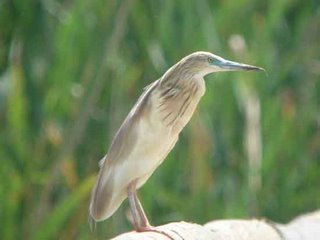A pretty week crossing Spain, from the north to the south, and crossing some of the natural spaces of Spain.
The first shutdown we did it in the National Park of Daimiel, natural space created by the confluence of two rivers, Cigüela and Guadiana.
This National Park, like the average Spain, is affected by drought and the little conscience of the people who live in the environs.
The aquatic birds, almost do not appear, since 2% of the floodable area are only flooded.
So the birds that live in the reeds, are the unique ones that cheers the visit, the most showy species were,
Bearded Tit,
Savi´s Warbler and
Aquatic Warbler. Other observed species in el National Park.
 Savi´s Warbler and Bearded Tit in the Field NotebookGreat Spotted Cuckoo
Savi´s Warbler and Bearded Tit in the Field NotebookGreat Spotted Cuckoo
Common Swift
Common Wood-Pigeon
Eurasian Hoopoe
Common Redshank
Pied Avocet
Black-winged Stilt
Whiskered Tern
Cetti's Warbler
Eurasian Reed-Warbler
Great Reed-Warbler
Common Nightingale
Crested Lark
Yellow Wagtail
Magpie
 Acuatic Warbler in the Field Notebook
Acuatic Warbler in the Field NotebookLater we followed course the south, again it is possible to be verified as the lack of water and mainly badly the use of the water this being an increasing problem. We arrived the Natural Space Cabo de Gata, with several remarkable points: The Rambla Morales, coastal lagoon of doubtless value by the presence of
White-headed Duck.
The salt pan of Cabo de Gata, one of the most interesting points for the observation of
Greated Flamingo and is not difficult to see birds rings.

The gullies of Cabo de Gata, places in which still it is possible to find really showy species like the
Lesser Short-toed Lark,
European Roller or the
European Bee-eater.
Birds observed in all Natural Space of Cabo de Gata.
Greated Flamingo
Eurasian Wigeon
Mallard
Common Pochard
White-headed Duck
Eurasian Hoopoe
 European Roller
European Roller
European Bee-eater
Great Spotted Cuckoo
Common Swift
Pallid Swift
Little Owl
Common Wood-Pigeon
Common Coot
Common Moorhen
Sanderling
Little Stint
Common Redshank
Common Ringed Plover
Kentish Plover
Eurasian Oystercatcher
Black-winged Stilt
Pied Avocet
Audouin's Gull
Whiskered Tern
Yellow-legged Gull
Slender-billed Gull
Black-headed Gull
Little Tern
 Gull-billed Tern
Gull-billed Tern
Black Kite
Common Kestrel
Little Grebe
Grey Heron
Little Egret
Woodchat Shrike
Carrion Crow
Eurasian Jackdaw
Magpie
Black Wheatear
Spotless Starling Lesser Short-toed Lark and White-headed Duck in the Field NotebookLesser Short-toed Lark
Lesser Short-toed Lark and White-headed Duck in the Field NotebookLesser Short-toed Lark
Crested Lark
Thekla Lark
Yellow WagtailOther visited natural spaces in the Southeast, the salt pans of Santa Pola where the Greated Flamingo ones were observed again.
Yellow-legged Gull
House Sparrow
Great Reed-Warbler
Little Egret
Purple Heron
Greater Flamingo
Great Crested Grebe
Black-winged Stilt
Pied Avocet
Whiskered Tern
Sand Martin
El Hondo area of reedbed partially flooded with cleared sand areas.

Birds observed in El Hondo area
Collared Pratincole
Yellow Wagtail
Black-winged Stilt
Pied Avocet
Little Grebe
Little Tern Squacco Heron
Squacco Heron
Thekla Lark
Grey Heron
Corn Bunting
Black-headed Gull
Common Coot
Zitting Cisticola
European Honey-buzzard
Again the problem of the bad management of the water maintains this natural space on the brink of disappearance and again the golf courses and the urbanizations proliferate by all the coast
 The last news on the collisions of birds in the windfarms are terrible, many White-tailed Eagle
The last news on the collisions of birds in the windfarms are terrible, many White-tailed Eagle  and Eagles finds the currents thermal that they use in his flights.
and Eagles finds the currents thermal that they use in his flights.


























